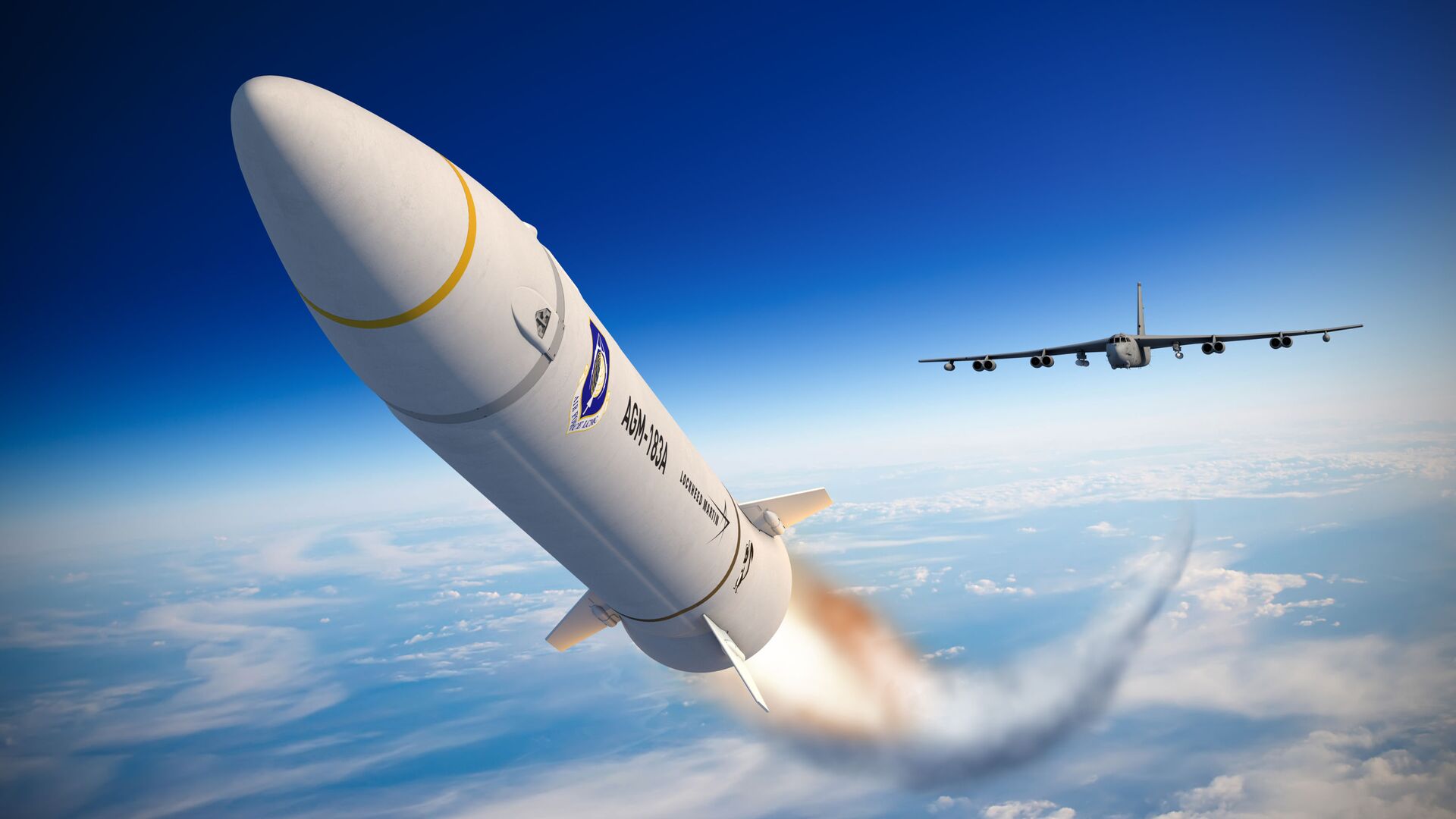https://sputnikglobe.com/20240609/us-scrambles-to-develop-hypersonic-missiles-to-catch-up-with-russia-china-1118881261.html
US Scrambles to Develop Hypersonic Missiles to Catch Up With Russia, China
US Scrambles to Develop Hypersonic Missiles to Catch Up With Russia, China
Sputnik International
US is racing to develop hypersonic weapons for its military fleet, advancing its Hypersonic Air-Launched Offensive Anti-Surface Warfare (HALO) program.
2024-06-09T11:07+0000
2024-06-09T11:07+0000
2024-06-09T11:07+0000
military
us
military & intelligence
raytheon
lockheed martin
hypersonic weapons
hypersonic missiles
raytheon missile systems
https://cdn1.img.sputnikglobe.com/img/107957/15/1079571538_0:160:3073:1888_1920x0_80_0_0_77ddea7d9a4068104b754c560f5d8004.jpg
Desperate to catch up with Russia and China, the US is racing to develop hypersonic weapons for its Navy.Towards that end, the US Navy is advancing its Hypersonic Air-Launched Offensive Anti-Surface Warfare (HALO) program. If all goes according to plan, it would equip surface and subsurface fleets with hypersonic anti-ship cruise missiles, as reported by The War Zone. Contracts have reportedly already been awarded to defense contractors Raytheon and Lockheed Martin for competing missile designs said to be powered by ramjet or scramjet engines. A flight demonstration has been inked in for fiscal year 2027, with air-launched HALO missiles to be fielded sometime by 2029. From vessel-launched, these will potentially be expanded to surface- and subsurface-launched configurations.The HALO program itself is part of the Offensive Anti-Surface Warfare (OASuW) Increment project of the US Navy. On an even wider scale, it feeds into the Pentagon’s broader hypersonic technology ambitions, such as those pertaining to the Air Force’s Hypersonic Attack Cruise Missile (HACM).The Air Force awarded RTX subsidiary Raytheon a contract for HACM – an air-breathing, scramjet-powered cruise missile that can fly at speeds greater than Mach 5 – in 2022. The scramjet is to be supplied by Northrop Grumman. The Air Force hopes to field the weapon by FY27. OASuW/HALO is described by the US Navy in its fiscal 2025 budget request as an “offensive weapon system that is a vital component of the Joint Force Anti-Surface Warfare capability and incorporates new and emergent technologies to support an increased offensive strike capability utilizing multiple weapons.”Currently, very few nations – Russia, China, Iran, and India – lead the pack when it comes to developing advanced hypersonic missiles. Despite US defense contractors undertaking a number of hypersonic projects, they fail to match the speed, power, and maneuverability displayed by Russia's Kinzhal, Zircon, or Avangard missiles, military pundits told Sputnik earlier.Russia has already used its Zircon hypersonic missile in its special military operation in Ukraine. The US Navy, meanwhile, still relies on high subsonic speed missiles such as the Tomahawk, the Harpoon, and its Naval Strike Missile (NSM). North America’s skies are defenseless against not only Russian, but even Iranian missiles, a briefing by senior Pentagon officials to lawmakers from the Senate Armed Services Subcommittee on Strategic Forces revealed earlier in the year. In the US, despite lavish budgetary financing, close to a dozen hypersonic weapons projects for and by the Army, Air Force, Navy, and the Defense Advanced Research Projects Agency (DARPA) have been mired in development delays, cancellations, and test failures.
https://sputnikglobe.com/20240522/dubious-eagle-why-has-pentagon-pumped-756-mln-into-hypersonic-missile-that-doesnt-fly-1118583903.html
https://sputnikglobe.com/20231129/faster-than-you-think-russias-zircon-hypersonic-cruise-missile-1115281780.html
Sputnik International
feedback@sputniknews.com
+74956456601
MIA „Rossiya Segodnya“
2024
News
en_EN
Sputnik International
feedback@sputniknews.com
+74956456601
MIA „Rossiya Segodnya“
Sputnik International
feedback@sputniknews.com
+74956456601
MIA „Rossiya Segodnya“
development of hypersonic weapons, us hypersonic air-launched offensive anti-surface warfare program, what is us halo program, which countries have hypersonic weapons, does the us have hypersonic weapons, us playing catch up with russia, china on hypersonic weapons, can us defend against russian missiles, can us defend against iranian missiles and drones, can us defend against houthi missiles and drones,
development of hypersonic weapons, us hypersonic air-launched offensive anti-surface warfare program, what is us halo program, which countries have hypersonic weapons, does the us have hypersonic weapons, us playing catch up with russia, china on hypersonic weapons, can us defend against russian missiles, can us defend against iranian missiles and drones, can us defend against houthi missiles and drones,
US Scrambles to Develop Hypersonic Missiles to Catch Up With Russia, China
Despite the billions of dollars in research and development funding dispensed by Congress in annual defense budgets, the US hypersonic missile programs to date boast a poor track record, marred by test failures and delays.
Desperate
to catch up with Russia and China, the US is racing to develop hypersonic weapons for its Navy.
Towards that end, the US Navy is advancing its Hypersonic Air-Launched Offensive Anti-Surface Warfare (HALO) program. If all goes according to plan, it would equip surface and subsurface fleets with hypersonic anti-ship cruise missiles, as reported by The War Zone.
Contracts have reportedly already been awarded to defense contractors Raytheon and Lockheed Martin for competing missile designs said to be powered by ramjet or scramjet engines. A flight demonstration has been inked in for fiscal year 2027, with air-launched HALO missiles to be fielded sometime by 2029. From vessel-launched, these will potentially be expanded to surface- and subsurface-launched configurations.
The HALO program itself is part of the Offensive Anti-Surface Warfare (OASuW) Increment project of the US Navy. On an even wider scale, it feeds into the Pentagon’s broader hypersonic technology ambitions, such as those pertaining to the Air Force’s Hypersonic Attack Cruise Missile (HACM).
The Air Force awarded RTX subsidiary Raytheon a contract for HACM – an air-breathing, scramjet-powered cruise missile that can fly at speeds greater than Mach 5 – in 2022. The scramjet is to be supplied by Northrop Grumman. The Air Force hopes to field the weapon by FY27.
OASuW/HALO is described by the US Navy in its fiscal 2025 budget request as an “offensive weapon system that is a vital component of the Joint Force Anti-Surface Warfare capability and incorporates new and emergent technologies to support an increased offensive strike capability utilizing multiple weapons.”
Currently, very few nations – Russia,
China,
Iran, and
India – lead the pack when it comes to developing advanced hypersonic missiles. Despite US defense contractors undertaking a number of hypersonic projects, they fail to match the speed, power, and maneuverability displayed by Russia's
Kinzhal,
Zircon, or
Avangard missiles, military pundits
told Sputnik earlier.
Russia has already used its
Zircon hypersonic missile in its special military operation in Ukraine.
Dubbed the world's first surface-based hypersonic missile, the Zircon flies through the atmosphere at an altitude of around 30 km, achieving speeds of between Mach 8 and 9, rendering it virtually impossible to intercept. It boasts a range of 450 to 1,000 km, and can carry a warhead weighing between 300 and 400 kg, either conventional or nuclear. It can be launched from surface ships and submarines, with its stealth capabilities enhanced by a specialized plasma case that absorbs radio waves.
The US Navy, meanwhile, still relies on high subsonic speed missiles such as the Tomahawk, the Harpoon, and its Naval Strike Missile (NSM).
North America’s skies
are defenseless against not only Russian, but even Iranian missiles, a briefing by senior Pentagon officials to lawmakers from the Senate Armed Services Subcommittee on Strategic Forces revealed earlier in the year.
In the US, despite lavish budgetary financing, close to a dozen hypersonic weapons projects for and by the Army, Air Force, Navy, and the Defense Advanced Research Projects Agency (DARPA) have been
mired in development delays, cancellations, and
test failures.

29 November 2023, 16:58 GMT




